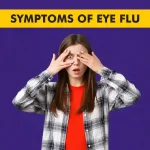Eye flu, also known as viral conjunctivitis, is a common condition that affects the eyes. It is caused by an infection with a virus, which leads to inflammation of the conjunctiva, the thin membrane that covers the white part of the eyes and the inner surface of the eyelids. Eye flu is highly contagious and can spread easily from person to person.
The eye flu symptoms can vary from mild to severe, and may include red eyes, itching or irritation, eye pain, watery eyes, swelling of the eyelids, sensitivity to light, and discharge from the eyes. These eye flu symptoms can be disruptive and uncomfortable, making it difficult to go about your daily activities.
In this article, we will explore major eye flu symptoms, its impact on daily life, and effective ways to manage and alleviate light sensitivity during eye flu.
What Is Eye Flu?
Eye flu, or viral conjunctivitis, is an infection of the eyes caused by a virus. It is highly contagious and can easily spread from person to person through direct contact with contaminated surfaces or through respiratory droplets from an infected person. The most common viruses that cause eye flu include adenovirus, enterovirus, and herpes simplex virus.
Eye flu can affect people of all ages, but it is more common in children. It is often associated with upper respiratory tract infections, such as the common cold or flu. The symptoms of eye flu usually appear within a few days of exposure to the virus and can last for one to two weeks.
Causes of Eye Flu (Viral Conjunctivitis)
Eye flu, or viral conjunctivitis, is caused by an infection with a virus. The most common viruses that cause eye flu include adenovirus, enterovirus, and herpes simplex virus. These viruses can be easily transmitted from person to person through direct contact with contaminated surfaces or through respiratory droplets from an infected person.
Eye flu can also be caused by other factors, such as allergies, irritants (like smoke or chemicals), or contact lens-related problems. However, viral conjunctivitis is the most common cause of eye flu.
Common Eye Flu Symptoms are Red eyes Itching or irritation Eye pain Watery eyes Swelling of Eyelids Sensitivity to light Discharge from the Eyes.
Eye flu, or viral conjunctivitis, is characterized by a range of symptoms that can vary from person to person. The most common eye flu symptoms include:
- Red eyes: The whites of the eyes may appear red or pink.
- Itching or irritation: The eyes may feel itchy or irritated.
- Eye pain: The eyes may be painful or sore.
- Watery eyes: Excessive tearing or watering of the eyes.
- Swelling of eyelids: The eyelids may become swollen or puffy.
- Sensitivity to light: Increased sensitivity to light, known as photophobia.
- Discharge from the eyes: The eyes may produce a watery or sticky discharge.
These eye flu symptoms can be uncomfortable and can interfere with daily activities. It is important to seek medical attention if you experience severe problems or if your symptoms do not improve within a few days.
Difference Between Eye Infection and Eye Flu
Eye infections and eye flu, or viral conjunctivitis, are two different conditions that affect the eyes. While both can cause similar eye flu symptoms, there are some key differences between them.
Eye infections can be caused by bacteria, viruses, or fungi. They can occur in one or both eyes and can affect different parts of the eye, such as the conjunctiva, cornea, or eyelids. Eye infections can cause symptoms like redness, itching, pain, discharge, and blurred vision.
On the other hand, eye flu, or viral conjunctivitis, is specifically caused by a viral infection. It primarily affects the conjunctiva, causing symptoms like red eyes, itching, watery eyes, and sensitivity to light. Eye flu is highly contagious and can easily spread from person to person.
If you suspect that you have an eye infection or eye flu, it is important to see a healthcare professional for an accurate diagnosis and appropriate eye flu treatment.
Eye Flu Preventive Measures
Preventing the spread of eye flu, or viral conjunctivitis, is important to protect yourself and others from infection. Here are some preventive measures you can take:
- Wash your hands frequently with soap and water, especially before touching your eyes or face.
- Avoid touching your eyes with unwashed hands.
- Avoid close contact with people who have eye flu or other contagious illnesses.
- Do not share personal items, such as towels, pillows, or makeup, with others.
- Clean and disinfect frequently-touched surfaces, such as doorknobs, countertops, and phones.
H2: Eye Flu Treatments
There are several eye flu treatment options available to alleviate your eye flu symptoms and promote healing. These include:
- Using over-the-counter lubricating eye drops to relieve dryness and discomfort.
- Avoiding contact lens wear until your eye flu symptoms improve.
- Taking over-the-counter pain relievers, such as acetaminophen or ibuprofen, to reduce pain and inflammation.
- Steroid eye drops must not be used without an ophthalmologist opinion.
Following your healthcare provider’s instructions for any prescribed medications or eye drops. Antibacterial eye drops may commonly be prescribed to prevent superadded infection. Steroid drops are added in some cases to manage inflammation.
It is important to note that eye flu is usually a self-limiting condition, meaning it will resolve on its own without any specific eye flu treatment. However, seeking medical attention can help manage your eye flu symptoms and prevent complications.
Myths and Facts About Eye Flu
Eye flu, or viral conjunctivitis, is a common condition that is often surrounded by myths and misconceptions. Here are some common myths and the facts behind them:
Myth: Eye flu is only caused by exposure to cold weather.
Fact: Eye flu is caused by a viral infection and can occur at any time of the year. Exposure to cold weather does not directly cause eye flu.
Myth: Eye flu can be cured with antibiotics.
Fact: Eye flu is caused by a viral infection, and antibiotics are ineffective against viruses. Antibiotics are only effective against bacterial infections.
Myth: Eye flu is not contagious.
Fact: Eye flu is highly contagious and can easily spread from person to person through direct contact or respiratory droplets.
Myth: Eye flu only affects children.
Fact: While eye flu is more common in children, it can affect people of all ages.
Myth: Eye flu can be spread by looking at an infected person.
Fact: Eye flu is primarily spread through direct contact with contaminated surfaces or respiratory droplets. It cannot be spread by simply looking at an infected person.
It is important to rely on accurate information and consult healthcare professionals for any concerns or questions you may have about eye flu.
Conclusion
Light sensitivity, or photophobia, is a common symptom of eye flu, or viral conjunctivitis. It can be disruptive and uncomfortable, making it difficult to tolerate bright lights or sunlight. If you experience sensitivity to light during eye flu, there are several ways to manage and alleviate this symptom:
FAQs
Can eye flu cause fever?
Fever is not a common symptom of eye flu. Eye flu primarily affects the eyes and may cause symptoms like redness, itching, pain, watery eyes, and sensitivity to light. Certain infections may however cause both fever and eye flu.
Can heat cause eye flu?
No, heat does not directly cause eye flu. Eye flu is caused by a viral infection and can be transmitted through direct contact with contaminated surfaces or respiratory droplets.
How long does eye flu last?
The duration of eye flu can vary, but it typically lasts for one to two weeks. Most people experience a gradual improvement in their symptoms over time.
What is the cure for eye flu?
Eye flu is usually a self-limiting condition, meaning it will resolve on its own without treatment. However, there are treatment options available to manage symptoms and promote healing.
Can I use my phone with eye flu?
It is generally safe to use your phone during eye flu, but it is important to practice good hygiene and avoid touching your eyes with unwashed hands. Clean your phone regularly to prevent the spread of germs.
How does eye flu spread by looking? Eye flu is primarily spread through direct contact with contaminated surfaces or respiratory droplets. It cannot be spread by simply looking at an infected person.
How do you treat eye flu?
Treatment for eye flu focuses on managing symptoms and preventing complications. This may include using lubricating eye drops, applying warm compresses, avoiding contact lens wear, and taking over-the-counter pain relievers.
Which tablet is best for eye flu?
There is no specific tablet that is considered the best for eye flu. Treatment options may vary depending on the severity of your symptoms and your healthcare provider’s recommendations.
What is the fastest way to cure an eye infection?
The treatment for an eye infection depends on the underlying cause. It is important to see a healthcare professional for an accurate diagnosis and appropriate treatment.
What is the use of Antibacterial eye drops?
Antibacterial eye drops may commonly be prescribed to prevent superadded infection. Steroid drops are added in some cases to manage inflammation.





